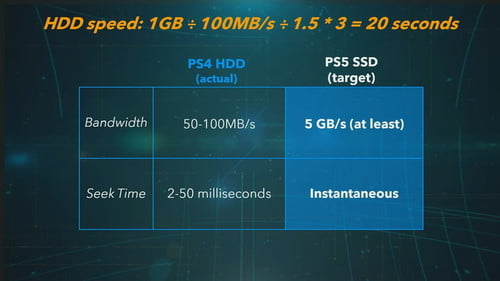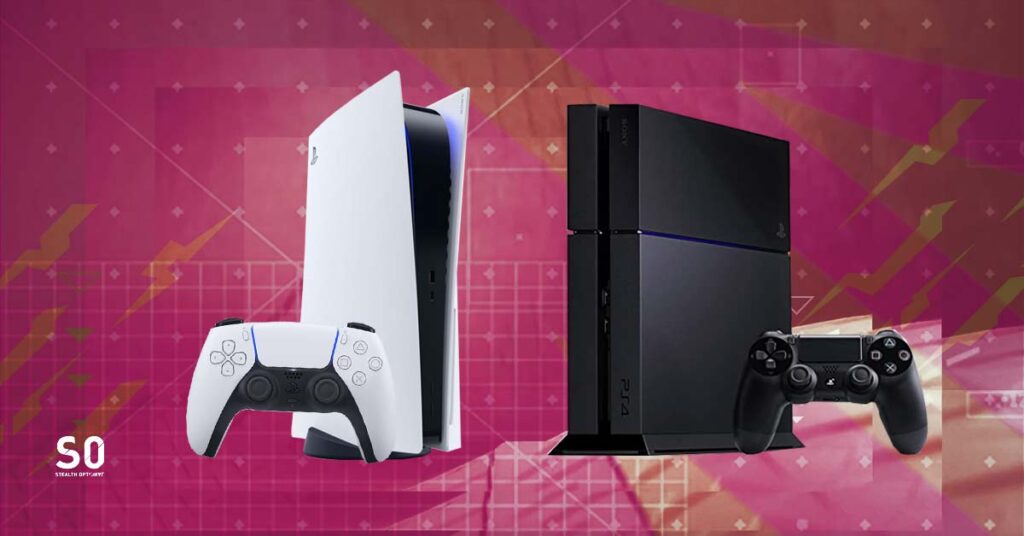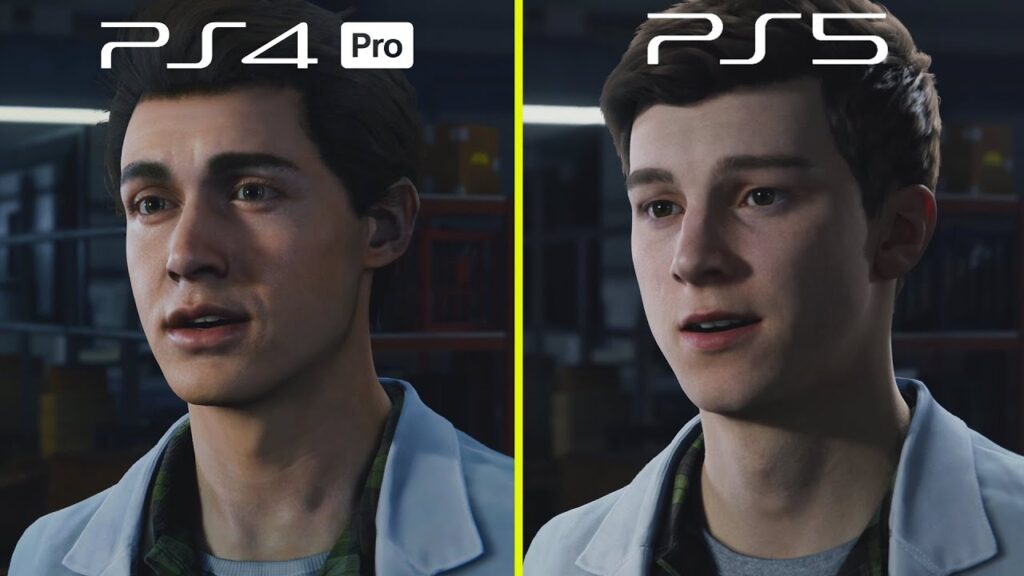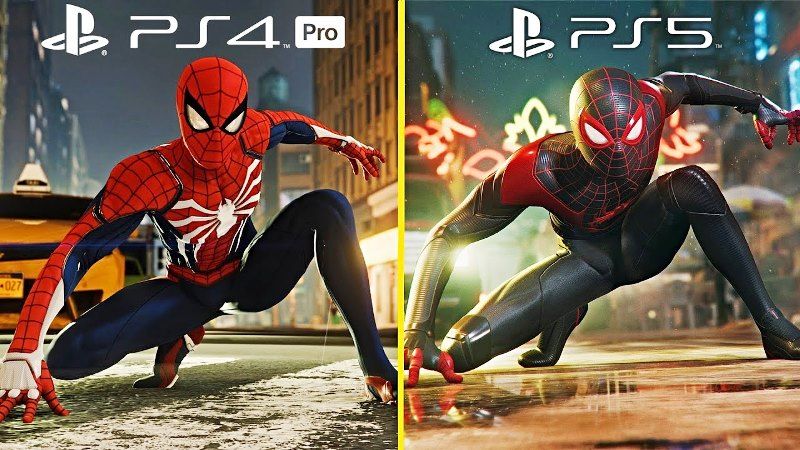The PlayStation 5 is finally here, and although it may not be the world’s fastest console, it’s a significant upgrade over the Playstation 4. With a whole new architecture, superior resolution support, and faster storage thanks to the SSD, the PS5 is better than the PS4 in almost every way.

From specs to design details to its expected game line-up, we know everything there is to know about the next-generation console. There’s a lot to talk about here, so let’s waste no time in comparing PS4 vs. PS5.
PS4 vs. PS5 specs:


Even a cursory glance at the specs of the PS5 shows that it’s in a different league than the PS4 (and even the PS4 Pro). Sony has improved the capabilities of its platform in every way, adding more efficient storage, faster compute parts, support for larger capacity disks, and support for higher resolutions. We know there are two versions of the PS5 — the Standard Edition and Digital Edition — both of which will offer the same specs (with the exception of the omission of a disc drive with the Digital Edition).
| PlayStation 5 | PlayStation 4 | PlayStation 4 Pro | |
| CPU | 8-core, 16 thread, up to 3.5Ghz (variable frequency) | 8 Jaguar Cores, 1.6GHz | 8 Jaguar Cores, 2.1GHz |
| GPU | 36 CUs at 2.23GHz, 10.3 TFLOPs (variable frequency) | 18 CUs at 800MHz, 1.84 TFLOPS | 36 CUs at 911Mhz, 4.2 TFLOPS |
| Memory | 16GB GDDR6 | 8GB GDDR5 | 8GB GDDR5 |
| Internal Storage | Custom 825GB SSD | 500GB, 1TB HDD | 1TB HDD |
| External Storage | NVMe SSD slot, USB HDD | 2.5-inch HDD, USB HDD | 2.5-inch HDD, USB HDD |
| Optical Drive | Ultra HD Blu-ray | Blu-ray | Blu-ray |
| Video Output | 4K at 120Hz, 8K | 1080p | 4K |
We’ll get into the specifics of most of these specs as we go throughout this comparison. As a general note, though, it’s important to consider the context of these specs. The PS5 is a much newer console built on a different architecture, and because of that, some of the specs shouldn’t be directly compared.
For instance, the PS5 and PS4 Pro have the same number of compute units (CU), but the PS5’s CUs have a much higher transistor density, making them more powerful than the PS4’s CUs. That said, other specs can be directly compared. The PS5 has a strictly better optical drive and resolution support, for example.
PS4 vs. PS5 graphics:

The PS4 and PS5 are both based on custom AMD Radeon chips, though the latter packs a lot more of a punch. Sony is boasting twice the number of CUs on the PS5, as well as significantly higher clock speed. However, the biggest difference between the two comes in the ever-important TFLOPs.

“Teraflops” is a hot term for console developers, and for good reason. Although TFLOPS aren’t holistically indicative of performance, it’s a solid number to refer to when making comparisons. The PS4, with its 18 CUs running at 800MHz, clocks in at 1.84 TFLOPS, meaning it can handle 1.84 trillion floating-point operations per second. By contrast, the PS5’s GPU is rated for 10.3 TFLOPs.
Referring to that single number, the PS5’s GPU is roughly eight times more powerful than the PS4 and two and a half times more powerful than the PS4 Pro. Sony is able to achieve such high performance because of the PS5’s 36 CUs and higher clock speed. Over the PS4, the PS5’s cores run at 2.23GHz with variable frequency.
The higher clock speed is expected, but we’re more interested in variable frequency. Speed is capped at 2.23GHz, though it will lower based on what’s required of the GPU. Locked at 800MHz, the PS4 varies power based on the workload to meet the clock speed. More demanding games require more power, but the speed is always 800MHz.
For the next generation, power is the constant and clock speed is the variable. In the PS5 technical reveal, system architect Mark Cerny explained why this was the case, stating that a graphics core with 36 CUs running at 1GHz would produce the same number of TFLOPs as a 48 CU core running at 750MHz — 4.6 TFLOPS — but gaming performance would not be equal.
The general idea is that higher clock speed is better, not more CUs, as the extra, slower units wouldn’t have enough computing work to pull their weight. By allowing variable frequency, the PS5’s GPU can achieve much higher clock speeds than expected, so long as the higher frequency can be supported by the system’s power budget.

So far, we’ve compared PS4 vs. PS5 graphics on raw numbers, but that doesn’t take into account the latter system’s more modern architecture. Each of the PS5’s CUs has roughly 60 percent more transistors than a PS4 CU. As Cerny pointed out in his presentation, that means the 36 CUs of the PS5 equal the same performance as 58 PlayStation 4 CUs.
In short, the graphical capabilities of the PS5 are massively more impressive than the PS4. The PS5’s GPU will have more cores, and those cores will be faster and more efficient.
PS4 vs. PS5 resolution:

The PS5’s increased graphical fidelity is, presumably, to push games to resolutions never seen before. For output, the PS5 supports 4K at 120Hz and 8K, both with variable refresh rate as determined by HDMI 2.1. By contrast, the base PS4 can output at 1080p, often decreasing resolution in-game based on power consumption, and the PS4 Pro can output at 4K.
Sony including an HDMI 2.1 output is very forward-thinking, even if most TVs don’t include an HDMI 2.1 port quite yet. The new standard supports higher resolutions and frame rates, but those upper limits won’t matter for years, or even decades. More important to gaming, HDMI 2.1 supports variable refresh rate, which will prevent screen tearing.

Going into the next console generation, we suspect resolution will be a key marketing point, as Microsoft and Sony have already pushed that their consoles are capable of 8K resolutions. Although this is true — and exciting, even — that doesn’t necessarily mean you’ll be playing games at 8K.
8K displays will likely become more common towards the end of the PS5’s life cycle. For now, the focus is on 4K. The big deal with the PS5 is support for 120Hz displays, as there’s already a slew of TVs and monitors that support 4K and higher refresh rates. Assuming the GPU has the horsepower to push 60 frames per second and above, you should be able to take advantage of a high refresh rate TV with the PS5.

PS4 vs. PS5 price:
With the massively improved specs and the implementation of the SSD, it makes sense that the PS5 will be more expensive than the PS4. The Standard Edition will cost $499.99, while the Digital Edition will set you back $399.99. Given the PS5’s speed and the fact that it’ll play 99% of your PS4 games, the value is absolutely there. You effectively would have no need for a PS4 once you get a PS5.
Interestingly, the PS4 isn’t much less expensive than the PS5. You can currently grab a 1TB PS4 Slim model for around $299.99, and a 1TB PS4 Pro for $399.99. At that point, you might as well grab a PS5, since it will do nearly everything the PS4 does — but better. It’s surprising to see such a minor price difference between the two, but with the current landscape of video games, console manufacturers must remain competitive with their prices.
PS4 vs. PS5 storage:

The PS5 isn’t seeing an upgrade in storage capacity over the PS4, or at least, over the PS4 Pro. If you’re still holding onto an original PS4, you’ll see slightly more storage, with the base PS4 model sporting 500GB of storage and the PS5 shipping with 825GB. Those with a later PS4 model or the Pro are actually seeing a decrease in capacity, losing about 175GB of space.
Performance is the key difference. The PS5 includes a custom SSD with a raw read bandwidth of 5.5GB/s. Sony’s new storage medium is built specifically for the PS5, allowing it to more effectively communicate with the PS5’s architecture. That’s why the 825GB capacity may seem a bit strange at first.
Even an off-the-shelf SSD would perform much faster than the PS4’s hard drive, with the older system rocking a 5400RPM mechanical disk. Beyond the performance benefit from flash-based storage, the PS5 also has a new SSD controller. This controller supports hardware decompression for ZLIB, but more importantly, Oodle Kraken.
Kraken is a newer compression and decompression algorithm from RAD Game Tools, which can compress files smaller than ZLIB, as well as decompress them faster. In practice, that means game files can be read from the flash modules, decompressed, and fed to the system much faster on the PS5 than on the PS4.
Current PS4 users have already benefited from efficient decompression, as recent games like Marvel’s Spider-Man and Star Wars Jedi: Fallen Order render based on what the player can actively see, loading extraneous data out from the game world. Up to this point, developers were forced to leave at least some assets in the game world, as the PS4’s hard drive isn’t fast enough to deliver the necessary data in time (think texture pop-in).
Games will load faster with the new SSD, that’s apparent, but developers also have more freedom in how they display assets. Because the PS5’s storage is as fast as it is, game files can be read from the storage device and delivered to the system within milliseconds, opening up far more possibilities in how game assets are displayed.
The biggest bottleneck is capacity, which thankfully, the PS5 has a solution for. Like PS4, you’ll be able to upgrade the storage of your PS5 with off-the-shelf parts. Instead of chucking in a 2.5-inch hard drive.
Compared to the PS4, you’ll see a significant performance boost with a PCI-e NVMe SSD over a 2.5-inch mechanical drive and even standard SATA SSDs. That said, the open nature of the PS4’s medium isn’t present with the PS5; you’ll need to wait until PCI-e 4.0-based drives hit the market before expanding the PS5’s capacity.
PS4 vs. PS5 games:
The PS4 has a long list of excellent exclusive games, including Bloodborne, God of War, Until Dawn, Uncharted 4, and more. Thankfully, you’ll still be able to play those games on your PS5 (more on that in a minute) — and in most cases, they’ll run and look better on the new machine. That’s the great thing about the new system. With backward compatibility in mind, all of your old PS4 games will still work on PS5.
But of course, the real reason to get a PS5 is for the games and there will be no shortage this fall. Standouts include Demon’s Souls, Marvel’s Spider-Man: Miles Morales, Godfall, and Sackboy: A Big Adventure. But the list of games doesn’t stop there. We know a God of War sequel is in the works, along with Final Fantasy XVI, Horizon Forbidden West, Gran Turismo 7, Death Loop, and a slew of others. The list keeps growing, but are the titles confirmed to come to PS5 (bolded games were available on launch day):
| Assassin’s Creed Valhalla | Dragon Age 4 | Hogwarts Legacy | No Man’s Sky | Returnal |
| Astro’s Playroom | Dustborn | Hood: Outlaws and Legends | NBA 2K21 | Riders Republic |
| Atomic Heart | Dying Light 2 | Horizon: Forbidden West | NBA Live 21 | Sackboy: A Big Adventure |
| Battlefield 6 | The Elder Scrolls Online | Hyper Scape | Observer: System Redux | Scarlet Nexus |
| Borderlands 3 | Far Cry 6 | Immortals: Fenyx Rising | Oddworld: Soulstorm | Sherlock Holmes: Chapter One |
| Bugsnax | FIFA 21 | JETT: The Far Shore | Outriders | Solar Ash |
| Call of Duty Black Ops: Cold War | Final Fantasy VII Remake | Just Dance 2021 | Overcooked: All You Can Eat | Stray |
| Chivalry 2 | Final Fantasy XVI | Kena: Bridge of Spirits | Outriders | Suicide Squad: Kill the Justice League |
| Chorus | Fortnite | Little Devil Inside | Paradise Lost | TemTem |
| Control | Ghostwire: Tokyo | LEGO Star Wars: The Skywalker Saga | The Pathless | Tribes of Midgard |
| Cris Tales | Godfall | The Lord of the Rings: Gollum | Planet Coaster: Console Edition | Unknown 9: Awakening |
| Cyberpunk 2077 | Goodbye Volcano High | Madden 21 | Pragmata | Vampire: The Masquerade – Bloodlines 2 |
| Death Loop | Gotham Knights | Maneater | Project Athia | Vampire the Masquerade – Swansong |
| Demon’s Souls Remake | Gothic | Maquette | Quantum Error | Warframe |
| Destiny 2 | Gran Turismo 7 | Marvel’s Avengers | Rainbow Six: Quarantine | Watch Dogs: Legion |
| Destruction: All-Stars | Grand Theft Auto V | Marvel’s Spider-Man | Rainbow Six Siege | The Witcher III: Wild Hunt |
| Devil May Cry 5: Special Edition | Haven | Marvel’s Spider-Man: Miles Morales | Ratchet & Clank: Rift Apart | Worms Rumble |
| Dirt 5 | Heavenly Bodies | Metal: Hellsinger | Recompile | WRC 9 |
| DOOM Eternal | Hitman III | Mortal Kombat 11 | Resident Evil: Village | Yakuza: Like a Dragon |
Backward compatibility:
Although the PS4 has a developed list of high-quality exclusives, that doesn’t mean you should sleep on Sony’s new console. In an official PlayStation Blog post, Senior Vice President of Platform Planning Hideaki Nishino explained how backward compatibility between PS4 and PS5 will work. Nishino started by saying “more than 99 percent of the 4000+ games available on PS4 will be playable on PS5,” and we now know how it’ll work.
PS5 will be backward compatible with PS4, PSVR, and games available through PS Now and PS Plus, with very few exceptions.

Surprisingly, there are only 10 games that will not be backward compatible with PS5. The list is as follows:
- DWVR
- Afro Samurai 2 Revenge of Kuma Volume One
- TT Isle of Man — Ride on the Edge 2
- Just Deal With It!
- Shadow Complex Remastered
- Robinson: The Journey
- We Sing
- Hitman Go: Definitive Edition
- Shadwen
- Joe’s Diner
Unfortunately, backward compatibility starts and stops with PS4 games. PS1, PS2, and PS3 games are not backward compatible, though we suspect Sony will maintain support for classic titles through the PlayStation Store, much like it has with the PS4.

In addition to new games, the PS5 also supports larger games than the PS4. Both the PS4 and the PS4 Pro have a standard Blu-ray drive. Blu-ray discs can store up to 25GB of data on a single layer, and although up to six layers are possible, the vast majority of Blu-ray discs don’t exceed two layers.
The PS5 ships with an Ultra HD Blu-ray drive, much like the Xbox One X. In addition to playing UHD movies off a disc, the new optical drive bay can take advantage of the capacities offered by Ultra HD Blu-ray discs. Currently, UHD Blu-rays support three capacities: 50GB and 66GB with two layers, and 100GB with three layers. Unlike standard Blu-rays, the higher capacities should be present on games.
PS4’s DualShock 4 vs. PS5’s DualSense:

Aside from vast differences between the two machines, the PS5 will offer a new take on the PlayStation controller — dropping the DualShock moniker entirely. Instead, the PS5 will come with the DualSense, a controller that is designed to include better battery life, adaptive triggers, and most impressively, haptic feedback. The idea with adaptive triggers is to offer varying degrees of resistance depending on what you’re doing in-game. For example, firing a bow will feel wildly different from firing an automatic machine gun, which will feel different from a shotgun.

The varying amount of tension is meant to make the player feel more immersed. Haptic feedback works similarly, but with the controllers’ vibration. Dynamic vibrations will be used to depict different surfaces or even showcase recoil with weapons. It will be up to the developer to design with adaptive triggers and haptic feedback in mind, so we hope games on PS5 will continue to include support for it. Based on early previews of the PS5, the DualSense seems to be the shining star.
Other than that, the DualSense and Dualshock 4 share many of the same features. They both have the same familiar button layout that you come to expect. The Share button has been replaced by a new Create button that allows you to live stream gameplay and share your favorite moments with friends. You’ll still find a built-in mic and headset jack, along with an integrated speaker, motion sensor, and touchpad.

PS4 vs. PS5 editions:
As we mentioned, the PS5 has two purchase options. One of these versions accepts disks, the other option stores digital copies of games purchased online. As mentioned above, the PS5 is available in two different models, including an option that accepts discs, as well as a disc-less, digital version. During the reveal, we looked at the systems themselves, which match the controller’s look and color scheme. The console has a white and black color scheme, with a slight curve in the middle. Without a built-in disk drive, the Digital Edition has a smaller, sleeker look, along with a slight height difference.

This two-pronged PS5 approach differs significantly from the PS4 launch, which only had one hard drive option back in 2013. Between then and now, we saw other iterations, such as the PS4 Pro and the PS4 Slim, but both emerged years later. We may see yet another iterative generation, in which Sony manufactures a smaller, more powerful version of the PS5.



